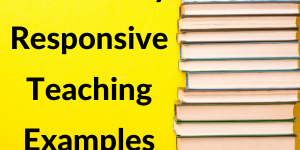As we get better at pulling out our phones and pulling up our cameras, the world is beginning to realize what BIPOC have known all along: racism doesn’t take breaks. Fighting systemic racism and dismantling institutional white supremacy happens at marches and protests, but it also happens in every other facet of our lives, especially in education.
Precisely since systemic racism doesn’t take breaks, it is not enough for us to be comfortably non-racist. To move forward, we have to be actively anti-racist, and in the context of education, this means implementing Culturally Responsive Teaching. Getting a concrete understanding of CRT can be difficult at times since it is a pedagogical approach rather than a simple lesson plan or implementable curriculum; that isn’t to say that there aren’t clear and concrete examples that can shed a bit of light, however. Here are five examples of Culturally Responsive Teaching.
Talk to Your Students
The most important aspect in making sure the curriculum reaches each and every student and that each and every student feels important and welcome is talking to them, getting to know them, and showing a genuine interest. This can take the form of individual meetings, of open and more social dynamics and activities in the classroom, or even general surveys to measure interests.
Not only will talking to your students shine a light on what your students like and what interests them, it’ll let you in on some of their struggles, some of their worries, even their insecurities. Assuming that every student will react to and take advantage of the curriculum the same way is a fundamental flaw in our education system and is a fundamental negligence that fosters systemic inequalities.
Recognize and Understand Culture
Closely related to talking to your students is understanding their culture and understanding the context in which they are receiving the education you’re offering. For children that primarily think in another language, receiving an education in English may not be only challenging, it can be alienating. Receiving academic instruction in a completely different language than they might receive instruction for chores at home paints the two settings as completely different worlds, and children that have to help translate at parent-teacher meetings have to jump through more hoops than other students that don’t have to think twice about what conjugation feels like in their next sentence, in their next context.
Teachers and professors certainly don’t have to become multi-lingual, or fully versed in every culture represented by their diverse classroom. Often, recognizing and showing an interest in being helpful can make an enormous difference. Speak with your students, get a feel for what elements of your teaching style might make it difficult to follow or understand for cultures that don’t align entirely with yours, and try to offer alternatives that are more accessible to everyone.
Include Relevant Content
In order to spark student interest, it’s important not only to diversify curricula but to do so with relevant content. Langston Hughes was an indispensable figure in the Harlem Renaissance and in championing Black intellectuality, but he’s also the only Black poet that every white 9th grade English teacher can pull out of the back of their mind, not to mention that no student is running home after English class to bump The Racial Mountain in their room.
Hughes is important and should be included in curricula, but Black poetry didn’t end in 1967. Perhaps an easy pick but an irrefutably relevant one nonetheless is Kendrick’s DAMN. Undeniably popular and rich with analyzable writing, a certain awards committee described the album as “a virtuosic song collection unified by its vernacular authenticity and rhythmic dynamism that offers affecting vignettes capturing the complexity of modern African-American life.” Conscious goes commercial while staying conscious.
Fitzgerald never won a Pulitzer, after all.
Engagement Across the Board
Sparking interest with relevant content is a big part of engagement, but so is making sure all students are able to engage. Some students are more visual, some are more tech oriented, some are hands-on, etc. If the entire curriculum is presented in one single manner, some students are bound to respond and engage more than others, even if the content is interesting.
Not only do students have different learning styles, they have different available resources. Students with regular access to computers and internet are at an immediate advantage when it comes to research projects. Students that can afford supplies are at an advantage when it comes to making poster boards. These advantages are as much technical as they are psychological.
Get to know what your students are interested in doing and get to know what they can do. How much of the project can be done during school hours with school resources?
Vibe Check
Don’t hop too far outside of your comfort zone. If a phrase is new to you and you don’t quite understand it (like the title of this section), opt to not use it, or ask your students to explain it to you. Understanding their vocabulary, their interests, and their culture is important, but understanding that some of their culture and mannerisms are theirs and not yours is important, too.
Recognize, learn, and appreciate, but be careful not to appropriate or overstep and make your students uncomfortable.
We hope that these 5 examples of Culturally Responsive Teaching helped to get you started. You can learn more on this page here, or contact us here for any inquiries or questions.






